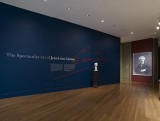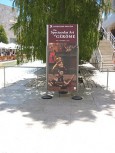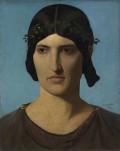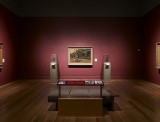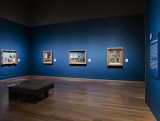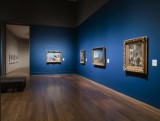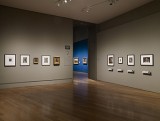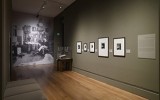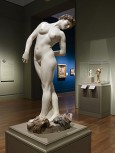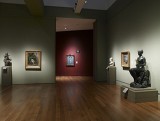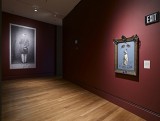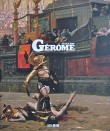The browser will either open the file, download it, or display a dialog.
The Spectacular Art of Jean-Léon Gérôme (1824–1904)
The J. Paul Getty Museum, Los Angeles
June 15 – September 12, 2010
Musée d'Orsay, Paris
October 19, 2010 – January 23, 2011
Museo Thyssen-Bornemisza, Madrid,
March 1 – May 22, 2011.
Publications:
Jean-Léon Gérôme, (1824–1904)
Edited by Laurence des Cars, Dominque de Font-Rélaux and Édouard Papet.
Published in conjunction with Musée d'Orsay and the Getty Museum;
Paris: SKIRA, 2010.
ISBN: 9788857207025
$75.00
Reconsidering Gérôme
Edited by Scott Allan and Mary Morton.
Los Angeles: J. Paul Getty Museum, 2010.
ISBN: 978-1-60606-038-4 (pbk.)
$27.50
The career, contribution, and place of Jean-Léon Gérôme in the art of the nineteenth century have waited a long time to receive definitive consideration and thorough examination. This reluctance to reconsider Gérôme is due to a number of factors, not the least being the way in which he opposed modernism through his intractable stance against the Impressionists, and more specifically to Gustave Caillebotte's bequest of Impressionist paintings to the French nation. More pertinent to the reasons why Gérôme's paintings (and to a lesser degree his sculpture), have been relegated to the dustbin of history is the belief among art historians and museum professionals who constructed the canon of Art History in the twentieth century, that his chosen themes corrupted the loftier purposes of art, thus leading to commercialism. Together with Post-Modernist critics, they also objected to his orientalism, which they disparaged for being untrue, a perversion or concoction of the true Orient. While we may concur with this assessment, we must also consider the fact that his vision of the Orient, or the vision he wanted to convey to his contemporaries, was not unique. We may also acknowledge a slightly different view advanced by the author of a very original book Empire of Landscape, Space and Ideology in French Colonial Algeria that presents an alternative view of orientalism.[1] While a small retrospective exhibition of Gérôme's work was organized in 1972 (Dayton Art Institute), and a detailed catalogue raisonné with a carefully developed text was published by the art historian and university professor Gerald Ackerman (1986, revised 2000), it was too early in our knowledge of nineteenth century art, and of Gérôme's place in it, to arrive at a clear picture of what Gérôme actually did accomplish. Now, with the exhibition at the Getty museum, and a larger version of the show opening at the Musée d'Orsay in October 2010, Gérôme is finally receiving the attention he deserves. No longer will he be lost in time, although his paintings, the way he developed them, and his relationship with many of the major issues of artistic creativity in the nineteenth century and beyond will remain controversial. Many of these issues raised by Gérôme's works are considered in the Getty exhibition itself or examined in essays published in the two volumes that accompany the retrospective. The most productive way to consider some of these aspects is by examining how the Getty installation helps a viewer understand Gérôme and his works through a nuanced thematic arrangement that places the artist within a historical continuum while also addressing the themes that he used in his works. Further discussion of the two publications accompanying the show will enlarge on issues not fully addressed in the Getty presentation of Gérôme.
Gérôme's Beginnings
Following a large photograph of the artist that introduces him to the museum public, a thematic wall text stresses what a controversial figure the artist was during his lifetime (figs. 1 and 2). It explains that he was at the center of several debates: he fought to maintain the academic tradition in the face of what he thought were the onslaughts of modernist painting, and his commercially viable compositions led others to see him as a supreme opportunist, one who was interested in monetary advancement and fame. After absorbing this wall text, the viewer was ready to examine Gérôme's works remembering that his creativity was representative of a different way of seeing the world, one at variance with the currently accepted traditions of nineteenth-century art history.
The first wall of the exhibition introduced his classical, Neo-Grec leanings seen best in a Portrait of a Roman Woman, (1844, The Cleveland Museum of Art, Noah L. Butkin Collection; fig. 3) and the Cock Fight (1846), the latter painting established Gérôme as a standout at the official Paris Salon for years to come. Even though some critics attacked the Cock Fight for being too self-conscious, the painting demonstrated that here was a young painter that had to be noticed. He was openly challenging the precepts that classical art had to have a high-minded purpose by combining classicism with an "intense naturalism" through the use of a theme that anyone could understand. The clarity of Gérôme's approach, the smooth paint surface to his canvases, and the realism of his figures and animals advanced his case. Placing this painting in the first exhibition alcove strengthened what the artist was setting out to do, and helped visitors understand the massive popular appeal that Gérôme's paintings had in the nineteenth century.
Across from the Cock Fight, were a series of paintings that might have gone unnoticed since they presented a so far little studied side of the artist's output: his interest in portraiture. From the Portrait of Armand Gérôme (1848) to the inclusion of a portrait of an unknown Woman, it is clear that Gérôme could have become a supreme portraitist, in the manner of Jean-Domninique Ingres, had he so desired. The portraits reveal the sitters' character; they convey a depth of personality that might be undervalued since a heavy emphasis in this exhibition was placed on Gérôme's better-known historical genre reconstruction and orientalist compositions. These portraits represent a side of Gérôme's work that shows him as a subtle observer of human traits.[2] We will return to other examples of his portraits later as close study of these paintings reveals what Gérôme might have become if he had followed this path.
Painting History
The second section of the exhibition revealed the various ways in which Gérôme was committed to reconstructing history so that the general public could understand it. Whether he was working within the context of contemporary history with the Death of Marshall Ney (1868) or trying to convey the drama and solemnity of Christ's crucifixion in Golgotha Consummatum est (1867), his scenes were instantly memorable: no one could forget them once they had seen them. Gérôme gave the impression that he had been an eyewitness to the event depicted, creating a documentary aura to a scene that was basically a fiction. Golgotha – also titled Jerusalem - is a case in point.
The crucifixion does not show the actual scene, as viewed by people standing in front of it; it is imagined and made concrete through the shadows the three crucified men cast on the ground—out toward the retreating soldiers, and against the broad panorama in the far distance of Jerusalem. Gérôme has removed the aura of religiousness in this composition, which generated considerable controversy when first shown in 1868. He used light to emphasize the supernatural impression, but the detailed setting looks photographic, belying the fact that Gérôme may actually have been using photographs to help him orchestrate his composition.
Gérôme's ability "to create" vast panoramic scenes peopled with large crowds is effectively shown in his Police Verso (1872) where the dominant gladiator looks to the crowd for a sign as to what he should do with his vanquished foe lying under his foot on the arena floor. This bloody, but effective vision of popular classical entertainment, has been used as the signature painting for the exhibition dominating the posters announcing the Getty show (fig. 2); it has been placed effectively in the exhibition in the middle of a wall where it is flanked by Gérôme's bronzes of other gladiatorial figures (fig. 4). Gérôme's use of a panoramic spectacle, his ability to specifically record the actual armor worn by combatants, made his work remarkably powerful. Undoubtedly, as the catalogue entry stresses, and as later noted in an essay, this painting, among others, "inspired filmmakers." But there can be little escape from the fact that in the nineteenth century, as now, this painting was both brutal and shocking as the artist was appealing to a crowd's basest instincts for cruelty.
As the "Painting History" section unfolds, as contrasts are made between Gérôme's reconstruction of ancient history and his fascination with current events, more wall labels could have been used to clarify a series of issues that are only explained in the catalogue. In this context, the presence of Gérôme's Reception of the Siamese Ambassadors at Fontainebleau becomes one of the seminal images in the exhibition. Completed at the time when Gérôme was becoming one of the central figures in the revision of courses at the École des Beaux-Arts, and at a moment when the leaders of the Second Empire were recognizing his ability with an official commission, the artist can be said to have assumed a mantle of distinguished authority. The accuracy of many of the portraits in this painting suggests a documentary reportage similar to Jacques-Louis David's composition of the Coronation of Napoleon and the Empress Josephine (known as Le Sacre), but with a clarity that signals the use of photographic sources for all the highlighted figures. While not everyone will appreciate this painting, its presence reinforces Gérôme's public persona as the artist of the time, the one who was going to train generations in his studio, instilling students with the necessity of modernizing the academic approach.
The Artist Ethnographer
Since Gérôme was most curious about the world in which he lived, he recognized the value in his desire to create paintings that looked increasingly real, of doing field research in places that he deemed worthy of his interest, and were fashionable in his own time. Like others in the nineteenth century, Gérôme traveled to the Near East. Called "the colonel" by those who accompanied him on his trips, Gérôme's military discipline was visible in his dawn until dusk workday, spent completing studies that he would rely on for his later paintings finished in his studio. This part of the exhibition focuses on the ways in which Gérôme created highly detailed scenes, such as the Carpet Merchant or the Snake Charmer, compositions where his imagination was abetted by photographs he had obtained of orientalist interiors, heightening the "illusion of reality" in the process (fig. 5). Subtly contextualizing Gérôme's themes, this section of the exhibition presents Gérôme's working method whereby he created themes that were both immensely popular and enhanced by his first-hand experience in the Near East.
In the midst of this section, curators Scott Allan of the Getty and Mary Morton, now of the National Gallery of Art, Washington, DC, placed Lion on the Watch (fig. 6). In contrast to the orientalist paintings on an adjoining wall, this canvas shows the artist as mythmaker. While superficially the lion would seem to belong in this environment, in fact, Gérôme would not have been able to observe lions in this part of Africa at the time of the painting. Importantly, the exhibition catalogue entry presents the real narrative. The lion has become the personal symbol for Gérôme. The animal's dignity, strength, and dominance—as visualized here—are identified with Gérôme himself, as ably revealed in an earlier article by the art historian Albert Boime.[3] Gérôme is now becoming his own master in this space of the exhibition where his orientalist scenes are perfectly matched with what the show is trying to say about the artist.
Photography
One of the most complicated issues to examine with regard to Gérôme is how and when he used photography to help him create paintings. This issue is linked to whether Gérôme was actually his own photographer or not, and whether he relied on photographs taken by others (or which he had purchased) to help him enhance his sense of reality in his paintings. The exhibition masterfully tries to answer some of the questions by structuring a section on photography in the middle of the presentation at the Getty.
A wall text notes that Gérôme engaged with photography from his student days with Paul Delaroche (one of his teachers) who had immediately recognized the value of the camera. More than this, through the placement of small paintings of pifferari done by Gérôme, the show organizers have stressed the impact of this new medium. These paintings are placed next to small photos, where the relationship is clearly evident (fig. 7). Along another wall, photographs either taken by Frédéric Auguste Bartholdi (who accompanied Gérôme on his trips to the Near East) or by Félix Bonfils or Abdullah frères are situated next to small reproductive photographs of paintings by Gérôme that were seemingly influenced by these photos. The excellent essay in the exhibition catalogue by Dominique de Font-Réaulx on "Gérôme and Photography" further suggests the complex ways in which Gérôme responded to, and used, photography, noting that he never hid the fact from anyone that he did use photographs to help his "illusion."
This area merges with the next one "Orientalism and Photography," known as "Reproducing Gérôme," where the Getty curators demonstrate how, through photography, Gérôme's paintings were made accessible to a very broad audience. His ties with Goupil & Cie, the most advanced company in art reproductions, helped advertise Gérôme's works. This relationship with the well-known art reproduction company (Gérôme became Goupil's son-in-law) added to the commercial viability of his compositions; and it helped to make him an increasingly wealthy individual.[4] By including this section in the exhibition, the curators have also tackled another difficult issue: how Gérôme became as famous as he did. In using a large photograph of an elderly Gérôme seated in the quiet of his studio, surrounded by objects he loved or created, the point also is effectively made that he was secure in his reputation as his career advanced (fig. 8). He also is, symbolically, watching over the visitors coming to examine his works at the Getty.
But one question remains: did Gérôme instill the use and interest in photography in his students at the École? Both P.A.J. Dagnan-Bouveret and Jules-Alexis Muenier either became exhibiting photographers on their own or used photography as aids for the creation of their own compositions. While these points are not mentioned either in the Gérôme show or in its publications, they could have been used to bolster Gérôme's obsession with photography as they reveal another way in which his own creativity continued to reach others.
Rethinking Orientalism
In this section Gérôme's orientalist paintings are brought into the center of contemporary discussions as to the nature of what an orientalist painting contained. Citing recent critical writing that questioned Gérôme's "scientific neutrality," his paintings are assessed for what they actually presented. Was he using cultural stereotypes for his figures? Was he constructing images that reinforced the west's view of superiority? When specific paintings in this section are examined, a more nuanced view emerges.
In his Veiled Circassian Beauty (1878) Gérôme's subtle portrait suggests not only the lingering impact of Ingres, the one artist against whom he measured his work, but also his ability to create a unified image that also reveals an actual person, not a type. In using the orientalist's appeal to sensuality, Gérôme has been able to meld this attitude with the western painting tradition. His Public Prayer in the Mosqueof Amr (1872) confirms Gérôme's interest in accuracy - it looks real. While the location is a seventh-century mosque (that was reproduced in photographs available to the artist), the scene depicted is "pure fantasy, despite its quasi photographic realism."[5] Gérôme's use of known details reinforced his ability to create compositions that were startling in their impact on an audience. Even his Muezzin (1866) suggests just how careful Gérôme had become in conveying the look of a spectacular scene. What also emerges is that with paintings, such as The Wailing Wall (1876), Gérôme created a seamless image an audience could believe. He had become a master at illusion; something the exhibition so carefully emphasizes; no one leaving the show is in doubt about Gérôme's accomplishment.
The Sculptor
The last section of the exhibition focuses on works that many might not associate with the artist. While he did work in sculpture throughout his career, albeit not on a continuous basis, this segment presents many large-scale colored sculptures that Gérôme exhibited in the Paris Salons (figs. 9 and 10). Although many critics of the time found his colored sculptures garish, and suggestive of waxworks, Gérôme continued to produce all types of pieces in a wide variety of sizes and materials. Obviously there was a tremendous worldwide interest in these pieces; Gérôme was eager to accommodate the commercial demand.
His portrait of the famed actress Sarah Bernhardt (1895-1901), made of tinted marble, is a personal homage to Bernhardt's talent and position as the leading actress of the era. Bernhardt almost seems to come to life in the sculpture as her smile, and her lively presence, belies the fact that there are a number of symbolic details on her costume that move the piece away from a realist depiction toward the utilization of Symbolist details as emblematic devices. Gérôme's understanding of the theme of the femme fatale, one of the dominant motifs of the era, led the artist to complete his Ball Player (1902) and Corinth (1903-04). Such pieces, in another medium, demonstrate that Gérôme was still very much connected to major ideas and issues present in the fin-de-siècle art world. With his creative powers undiminished, the small paintings on the theme of Pygmalion that he completed at this time show how the painter, haunted by his own statuary, continued to create in the quiet of his studio.
The show comes to a close with Gérôme's witty Optician's Sign (1902) a work that underscores the artist's sense of humor and his ability to contribute a work to a contest dedicated to advertising signs for the City of Paris (fig. 11). The surrealist mockery, his heightened visual puns, suggest that he was well aware of, and is known to have attended, the outlandish Chat Noir cabaret performances; and noted the creation of signboards for this fabled location. In such a fanciful work, Gérôme shows himself a consummate visual magician, highly capable of manipulating his audience into believing his contrivances as the truth.
The Publications
The exhibition generated two publications. The first, a series of essays edited by Scott Allan and Mary Morton, entitled Reconsidering Gérôme, presents a wide range of issues that grapple with aspects of Gérôme's work: a reassessment or orientalism; how Gérôme constructed some of his best known history paintings, such as the Death of Caesar; and how moviemakers were inspired by his detailed and visually arresting reconstructions of the past, provocatively discussed in Marc Gottlieb's "Gérôme's Cinematic Imagination" (fig. 12). Existing more as sketches for further investigation rather than as definitive studies, these essays are useful in our continued understanding of Gérôme.
The larger publication is a traditional catalogue for the exhibition itself, researched and written by French and American curators, and art historians involved with the exhibition (fig. 13). Composed of thematic essays of varying substance and depth, combined with exceptionally thorough catalogue entries on all the works in the exhibition either at the Getty or the Musée d'Orsay, the book provides exceptionally useful information on the works in the show. Occasionally, as with the essays by Scott Allan or Mary Morton, new insights are presented that bode well for future appreciation of Gérôme, including ways in which he found very wealthy collectors in the United States. The essays on Gérôme's sculpture and on his ties with the movies contribute considerable insight on how Gérôme created his works, or how he has been used as a basis for further illusions in the cinema. These two publications will be useful to the museum visitor or to anyone interested in furthering their knowledge about Gérôme after the exhibition closes.
With this said, the catalogue for the exhibition comes with serious flaws. First, the color work throughout is poor, and does not do justice to the paintings on display; the images are often muddy representations of the far more luminous works themselves. Since color is a very significant part of Gérôme's work, it is too bad that the color reproductions do not always do justice to the originals. Possibly more bothersome is that nowhere in the catalogue is it stated which of the objects at the Getty will not be shown at the Musée d'Orsay, or which of the pieces that will be shown in Paris were not shown in Los Angeles. This is confusing to the reader who has to search through the book to see if a work has been missed, and it easily could have been taken care of in the individual entries for each work.
Aside from these issues the exhibition (and its publications) go a long way toward our appreciation and understanding of one of the nineteenth century's misunderstood creators. While his art is indeed "spectacular," what is really awe-inspiring is the way in which this exhibition has been mounted and conceived. It is a marvel of comprehensiveness and intelligence in its ability to make Gérôme worthy of humanistic study and cultural interpretation. It must be roundly applauded.
Gabriel P. Weisberg
University of Minnesota
Vooni1942@aol.com
[1] See John Zarobell, Empire of Landscape, Space and Ideology in French Colonial Africa (University Park: The Pennsylvania State University Press, 2010).
[2] One of the most significant of these early portraits is Gérôme's canvas of the actress Rachel (1859). While not in the Getty version of the show, it will clearly add considerable originality in Paris. The catalogue entry does genuine justice to the importance of the painting.
[3] See Albert Boime, "Gérôme and the Bourgeois Artist's Burden," Arts Magazine 57, no. 5 (January 1983): 70. Referenced in Jean-Léon Gérôme (1824-1904) (Paris: Skira, 2010), 199-201.
[4] On this point see the exhibition catalogue Gérôme & Goupil. Art and Enterprise (Paris: Éditions de la Réunion des musées nationaux; Bordeaux: Musée Goupil; Pittsburgh: Frick Art and Historical Center; and New York: Dahesh Museum of Art, 2000). Also see Hélène Lafont-Couturier, "La Diffusion de l'oeuvre de Gérôme par la maison Goupil en France et aux Etats-Unis," in Thomas Eakins: peinture et masculinité (Giverny: Musée d'Art Américain; Terra Foundation for the Arts, 2003).
[5] See Jean-Léon Gérôme (2010), 246.


